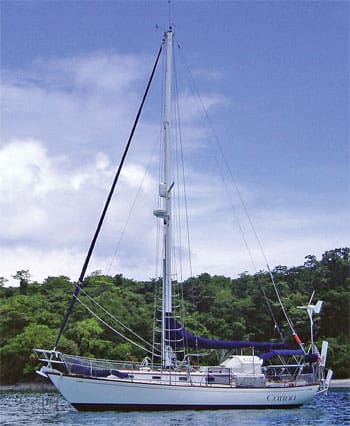In the eight years we have traveled outside of the U.S. on our Mason 33, Carina, efficient communications have been essential for the management of our cruise and to maintain our safety.
Digital communications
E-mail aboard is critical to us; if we did not have onboard e-mail we would spend less time out cruising and more time in port. Our e-mail suppliers are: Winlink, SailMail and Yahoo (for our www.sv-carina.org mail) with each providing a niche.
Winlink is a free, radio-based e-mail system requiring a minimum general class amateur license and we access it at sea via an SSB radio and Pactor III modem. Winlink is our choice for acquiring weather such as GRIB and high seas forecasts, regional forecasts, and files such as surface charts which may come as an attachment. Each Winlink host station allocates significant time enabling us to receive large weather files without exhausting privileges.
SailMail is also a radio-based e-mail system, though there is a $250 per year cost. A ship’s station license is required. SailMail has a connect time limitation and will not allow attachments. The supporting software, AirMail (used by both Winlink and SailMail), is free and permits weatherfax acquisition and viewing, plus position reporting. When an Internet connection is available, AirMail allows uploads and downloads of e-mail enabling a seamless transition from passages to anchorages.
SailMail also maintains Saildocs, a catalog of hundreds of (primarily) weather files available free via e-mail, either by single request or subscription. Saildocs will also forward the text content of a website, allowing for limited Web access even while at sea.
Other unique features of SailMail include its relay function and Shadowmail. The relay function allows for one message to go to a long list of recipients with each receiving a personally addressed e-mail. We use this to keep our friends and family (250-plus individuals) up to date with our adventures. Shadowmail is a service that allows for monitoring e-mail from a land-based service such as Yahoo, Gmail, etc., even when at sea. A separate Shadowmail folder in the AirMail folder includes a list of e-mail received in a land-based account, including sender and subject. Any e-mail listed can be deleted or forwarded, archived, etc. With Shadowmail we never miss a critical e-mail when we are at sea or swinging at anchor in a remote location.
We use our land-based e-mail for all mail with attachments of any significant size — e.g., documents we need to print and send back, photos from family and friends, etc. In addition, it’s important for use with commercial enterprises (such as Internet retailers) so that our SailMail and Winlink limited-bandwidth e-mails are protected from unsolicited marketing. With Shadowmail, we can easily monitor this e-mail remotely.
High-frequency radio communications
Our voice communications include ship-to-ship networking with other boats and ship-to-shore communications with worldwide amateur radio (ham) operators who under certain circumstances can provide telephone patches.
Participation in amateur radio nets requires a license but — this is important — any vessel in distress will be assisted. When on passage, we check in once a day with our position and weather conditions. Our position is reported to monitoring agencies and our weather data to meteorologists in the interest of perfecting weather forecasting. If we have a failure or a medical emergency and require assistance, the amateur operators coordinate assistance.
We also participate in one or more regional marine nets, which meet at specific times and provide invaluable support. Vessels without SSB radios who cannot participate become almost invisible to the cruising community.
VHF radio
For local ship-to-ship communications, we use VHF radio, though there seems to be a recent and disturbing tendency of boats not monitoring hailing channels. This practice undermines everyone’s security. Many popular anchorages have daily VHF nets with discussions of events, safety and weather.
Cell phones
If we’ll be in a country awhile, we usually purchase the least expensive GSM cell phone on a prepay basis and use it for local communications — voice and text — as well as for an occasional call back to the U.S. Cell phones are connecting even the most remote villages to the outside world, so coverage is nearly comprehensive.
Internet access
In recent years, Internet access has become almost universally available in port via Wi-Fi emanating from restaurants, resorts or marinas. Where we can gain access, we take advantage to download land-based e-mail to our laptop, update virus and phishing software, research ports of call and marine supplies, acquire satellite photos of remote anchorages and publish to our website via FTP.
We use Internet cafes for Skype, or to transfer large files, though we always use our own laptop for security reasons. We’ve found Internet cafes just about everywhere we have cruised except in the way-out-there islands of the South Pacific. The cheapest cafes were in Panama; the most expensive in Vanuatu. Most Internet cafes outside the U.S. also offer excellent and inexpensive land-based telephone service for those times when you must use a dedicated, secure, landline.
Where available — Fiji was the best with 3G coverage — we purchase a small USB modem stick for Internet access. Digital signals emanate from cell phone towers so coverage includes remote anchorages, though the quality of the signal varies widely. When the connection is good, it’s quite a luxury.
——————————–
Leslie Linkkila and Philip DiNuovo live aboard their Mason 33 Carina. In 2003, they departed Seattle and have cruised throughout Pacific Central America, Ecuador and the Galápagos. Their website is at www.sv-carina.org. They are currently in Losalava, Gaua Island, Vanuatu.

